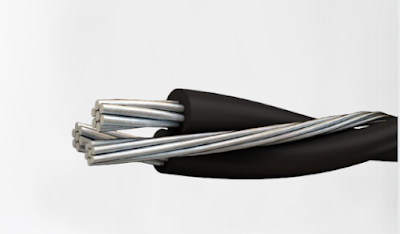Everything You Need to Know About 22KV Cable
A power cable with the capacity to transport high voltage electrical energy from one location to another is known as a 22kV cable. It is normally composed of a conductor, an insulation material, and an outer protective layer, and is used to transport and distribute energy in medium- to high voltage power systems.
The cable's 22kV rating relates to its operating voltage level, which is higher than that of the majority of standard low voltage power lines.
Features of 22kv cable
22 kv cable current rating
The maximum voltage that a cable is intended to withstand without malfunctioning is referred to as voltage rating. A 22kV electrical cable, for example, is made to transport electricity at a voltage of 22 kilovolts (22,000 volts). This qualifies it for usage in high voltage power systems where the voltage surpasses what conventional low voltage cables can handle.
Copper or aluminum is the conductor material
The component of the cable that transports electrical current is known as the conductor.
Aluminum or copper can be used to create a 22kV electrical cable. Aluminum is not as good of a conductor as copper, hence it is utilized in high-end applications where strong conductivity is necessary.
Aluminum is a common choice in applications where cost is a major consideration because it is lighter and less expensive than copper.
Size of the conductor
Depending on the application and the distance to be covered, it typically ranges from 16 mm2 to 1000 mm2.
The amount of current a cable can carry depends on the size of its conductors.
Depending on the purpose and the distance it must travel, a 22kV electrical cable's size might range from 16mm2 to 1000mm2. Higher currents must be carried by larger conductor sizes, which also lower cable resistance.
Material used in insulation
Insulation materials include ethylene-propylene rubber (EPR) and cross-linked polyethylene (XLPE). The conductors are kept apart from one another and the environment through insulation.
In a 22kV electrical cable, ethylene-propylene rubber (EPR) or cross-linked polyethylene (XLPE) is frequently used as insulating material. Both materials are appropriate for high voltage applications and have strong insulating resistance.
Shielding
Metallic shielding is frequently used to block electrical interference and lower the possibility of electrical problems.
The use of shielding helps prevent electrical problems and protect the wire from interference.
A tape or wire braid made of a metallic substance is frequently used to insulate 22kV electrical cables. A layer of defense against electromagnetic interference, which might result in unwanted electrical impulses in the cable, is provided by the metallic shielding.
Jacketing material
Polyvinyl chloride (PVC) or low-smoke, zero-halogen (LSZH) material is used as a jacketing material. The cable is shielded by the jacketing material from external harm like abrasion and moisture. Low-smoke, zero-halogen (LSZH) or polyvinyl chloride (PVC) material is frequently used to jacket electrical cables rated for 22 kV.
PVC is a typical jacketing material that is frequently used in situations where cost is a major consideration. While more expensive, LSZH material is a safer alternative because it produces less smoke and harmful chemicals in the event of a fire.
Temperature
Operating temperature: Usually capable of working in a range of -25 to 90 degrees Celsius.
A cable's working temperature must be taken into account because it has an impact on the performance and durability of the cable.
The usual operating temperature range for a 22kV electrical cable is between -25°C and 90°C. This temperature range makes sure the cable can function dependably in various climates and with various loads.
Size and Specification of 22 KV Cable
The size of a 22kV electrical cable can vary depending on the application and the distance it needs to cover. The conductor size of
cable determines its current-carrying capacity and is usually selected based on the maximum current that the cable is expected to carry. The size of a 22kV cable is typically larger than that of a low voltage cable due to the higher voltage level.
The conductor size of a 22kV electrical cable can range from 16mm2 to 1000mm2 or more, depending on the specific application. However, the most commonly used conductor sizes for 22kV cables are in the range of 120mm2 to 630mm2.
The size of the cable is also influenced by factors such as the length of the cable, the ambient temperature, and the type of installation. For longer cable runs, larger conductor sizes may be required to compensate for voltage drop over the distance of the cable.
It's important to note that the specific cable size required for a particular application should be determined by a qualified engineer or electrician, who will take into account all the relevant factors and select the appropriate cable size to ensure safe and reliable operation.
Uses of 22kv cable
A 22kV electrical cable is a high voltage cable that is generally employed in medium- to high voltage power networks for the transmission and distribution of electrical power.
Transfer electricity
Electricity is transmitted over great distances via 22kV cables from power plants to distribution substations.
Distribution
Electrical power is sent from substations to consumers in the industrial, commercial, and residential sectors using 22kV lines.
Industrial uses
22kV cables are employed in a number of industrial uses, including the energization of huge motors, pumps, and other heavy machinery.
Renewable energy
22kV cables are used to transfer electricity from generators to the grid in renewable energy systems, like wind farms and solar power plants.
Conclusion
A 22 kV electrical cable is a high voltage power cable that is designed to carry electrical power at a voltage level of 22 kilovolts (22,000 volts) over a distance. It is made of a conductor material (copper or aluminum), insulation material (XLPE). The 22 kV cable price list is competitive at Znergy Cable.
Znery Cable is an electrical cable company in Australia manufacturing superior quality electrical cables for residential, commercial, industrial, and infrastructure purposes that comply with industry standards.




Comments
Post a Comment